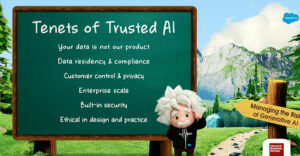Salesforce’s secret weapon has always been an all-out effort to appeal to every stratum of the market. Whether with small businesses or enterprise-level organizations, they position themselves as a solution. They also cover major industry sectors, including finance and health care, to give a sense of breadth.
Salesforce is at it again, though you could be skeptical of the “again” aspect since they’ve never really stopped. The latest entry-level offering that provides all-in-one functionality is called Salesforce Starter, and it seems like a good first step for a small business, but especially for small businesses that want to get large.
We forget it now, but not that long ago, we had categories of CRM that included enterprise and SMB, and the two were decidedly different. Most CRM analysts had to decide which coverage to focus on.
CRM Systems Segmentation to Integration
Today, thanks to the platform technologies that undergird most CRM systems, the difference means little, and most analysts I know cover everything. Ironically, this means a steady state or even growing analyst pool and fewer vendors, though the vendors cover what used to be separate markets.
It’s not unusual today for a customer to start small and expect to keep growing with the same vendor. Back in the day, growth meant a painful CRM conversion at least once in a company’s life and possibly more. Workarounds that incorporated best-of-breed technologies were a common way of putting off the conversion to some better time that never seemed to come.
But it’s not just platform technology that makes it possible for a CRM vendor to serve so many diverse markets. The economics of platforms that service small businesses benefit enterprises as well as CRM vendors. Build something that a small business can figure out, and chances are good that the big guys will be able to also.
Every CRM vendor I know of has some kind of self-teaching facility as well as a network of partners that can do the heavy lifting associated with customization.
This ability to serve the whole marketplace and to do it economically is another demonstration that CRM has reached a peak. From a peak, you shouldn’t immediately think that the only next direction is decline. From a peak, you go to a plateau, and that can be a long time.
CRM has established itself as an essential tool for modern business, and the addition of AI demonstrates that a plateau is forming. Since AI is in its infancy, that formation could extend far into the future.
In this scenario, developing a feeder system in which new recruits become big customers is very good for survival. But such a system, supported by all the CRM vendors today, means a kind of stasis could invade the market. That would be a different problem that, thankfully, is not yet on the horizon.
Zero-Sum vs. Grassroots Growth
For now, CRM vendors have to decide on one of two strategies.
Plateaus represent a kind of steady state growth that can either come from a zero-sum game in which you take away your competition’s customers or from recruiting at the grassroots. In either case, there will be annual attrition.
Zero-sum works in both directions, of course, and it can be expensive. But zero-sum also hits the books in a more dramatic fashion than recruiting new, small companies.
In practice, I see both happening, though some vendors are more interested in playing the zero-sum game. It’s my bet that you need both but with an emphasis on recruiting small customers, hence the importance of Salesforce Starter.


























































Social CRM
See all Social CRM